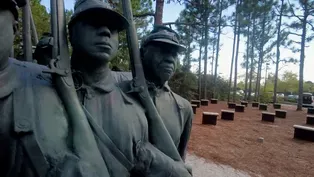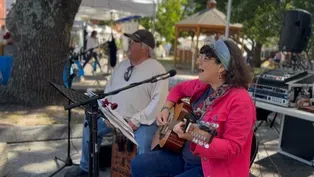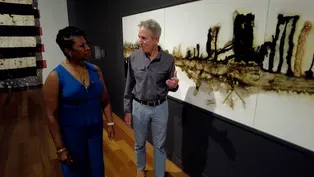
U.S. Life-Saving Stations
Clip: Season 22 Episode 6 | 12m 5sVideo has Closed Captions
Tour the historic Chicamacomico and Pea Island Life-Saving Stations in the Outer Banks.
Before the Coast Guard, there was the U.S. Life-Saving Service. Learn why the agency was so integral to coastal travel as we tour its historic Chicamacomico and Pea Island Life-Saving Stations in the Outer Banks.
Problems with Closed Captions? Closed Captioning Feedback
Problems with Closed Captions? Closed Captioning Feedback
North Carolina Weekend is a local public television program presented by PBS NC

U.S. Life-Saving Stations
Clip: Season 22 Episode 6 | 12m 5sVideo has Closed Captions
Before the Coast Guard, there was the U.S. Life-Saving Service. Learn why the agency was so integral to coastal travel as we tour its historic Chicamacomico and Pea Island Life-Saving Stations in the Outer Banks.
Problems with Closed Captions? Closed Captioning Feedback
How to Watch North Carolina Weekend
North Carolina Weekend is available to stream on pbs.org and the free PBS App, available on iPhone, Apple TV, Android TV, Android smartphones, Amazon Fire TV, Amazon Fire Tablet, Roku, Samsung Smart TV, and Vizio.
Providing Support for PBS.org
Learn Moreabout PBS online sponsorship- Before the Coast Guard, there was the United States Lifesaving Service, and the year 2024 marks the centennial of this fascinating chapter in our coastal history.
Let's head to the Outer Banks with Rebecca Ward to learn more about our lifesaving legacy in this state.
[waves crashing] - There's 5,000 shipwrecks out there.
Some of them were before there was a lifesaving service, some of them were after.
The graveyard out there might be just the ship.
Our job is not necessarily to save ships, it's our job to save the people.
- [Rebecca] Before the modern US Coast Guard came the United States Lifesaving Service, or the US LSS.
- This isn't just the lifesaving service that became the Coast Guard.
This is America's history.
- [Rebecca] The surfmen who served in the US LSS in North Carolina saved lives in one of the most dangerous maritime regions in the world, nicknamed the Graveyard of the Atlantic.
With little more than wooden boats, ropes, and line throwing guns, North Carolina surfmen risked their lives in severe weather conditions, often in the dead of night to rescue strangers.
- This is not local history, this is national history.
We always tell people it's not just the history of the United States Lifesaving Service and what surfmen did.
You know, all the dots connect, from the Civil War, the fight for freedom, Black watermen.
- [Rebecca] The legacy of the US LSS in North Carolina can be explored underwater and on land.
Let's start at Cape Hatteras National Seashore.
[dramatic music] The history of the US LSS in North Carolina begins in 1874.
When our first seven stations were built along the Outer Banks.
[soft music] - Congress had allocated $200,000 to build some stations in North Carolina.
The superintendent of the lifesaving service was a fellow named Sumner Kimball, and he had targeted the Outer Banks because of the Graveyard of the Atlantic out there.
Chicamacomico is the most complete lifesaving station museum in the United States.
We have an 1874 station.
We have the 1911 station.
Our mission is to preserve the stories of the men who served in the United States Lifesaving Service, and the men who served in the early Coast Guard along the coast of North Carolina.
- So what is the Graveyard of the Atlantic?
- The Graveyard of the Atlantic is the resting place of over 5,000 shipwrecks over the course of history.
- But why right here off the coast of North Carolina?
How is it different than say, anywhere else on the east?
- Couple of different reasons.
One is the weather patterns.
The weather patterns change frequently and quickly.
The other is the clash of the Labrador Current with the Gulf Stream.
They meet out there, which causes the water to swirl and swirl for miles and miles.
The other is shoaling.
- Shoals are natural underwater ridges or banks formed by tides, currents, and waves.
Unlike land, which is a fixed and visible feature, shoals are often hidden beneath the water's surface, and they shift over time.
So Hatteras Lighthouse is built right off the coast of the Graveyard of the Atlantic on Cape Hatteras.
It's over 200 years old, and it's the tallest lighthouse in the United States.
While lighthouses can show where land is, they can't mark underwater hazards or rescue mariners in danger.
- They had built these stations, but then they didn't man them.
To save money, they said we're only gonna man them during hurricane season.
So the Huron, within sight of a station, people drowned, but the station was not open yet.
Thomas Nast, our very famous political cartoonist, drew a cartoon of Uncle Sam hanging his head in shame on the beach with bodies rolling up out of the surf saying, "I guess we're gonna have to spend some money," and then the lifesaving service went 12 months a year.
- [Rebecca] The tragedy of the Huron led to the construction of even more lifesaving stations along our coast, including the Pea Island station.
- Right now, you are on Roanoke Island in Manteo, North Carolina at the Pea Island Cookhouse Museum.
It was the building where people who served in the United States Coast Guard cooked.
The Pea Island station was primarily staffed by Black keepers for 67 years.
My father, Herbert M. Collins, would've been the last left in charge of the station, so he served there the duration of World War II.
His grandfather served at the station, his uncle served at the station.
His great uncle served at the station.
You know, my ties to that station obviously run deep.
This museum honors the history of Richard Etheridge and the Pea Island Lifesavers.
Richard Etheridge was once enslaved.
He was the nation's first Black keeper in the United States Lifesaving Service, and the station that he commanded is the only all Black station in the history of the United States Lifesaving Service.
He ended up fighting in the Civil War for freedom, returning to Roanoke Island, and eventually getting a job with United States Lifesaving Service.
So, you know, his story is also the story of Black watermen, the enslaved who were raised by the water, although they were enslaved, they would've been used to fish, to guide people through these difficult waterways.
You know, they were the experts on the ocean.
It's 1880.
Etheridge is put in charge, and the whites who were at the station, you know, couldn't, wouldn't, didn't, whatever you wanna call it, but that's, you know, that's the start of Etheridge kinda getting an all Black crew.
Then shortly after that, the station is burned to the ground.
There's no one, as I understand it, who was ever accused officially of starting the fire.
In the end, that doesn't stop Etheridge and his crew, you know, this new station is built, you know, they're working with stations, they're doing their thing, participating in joint rescues with other stations, so I think over time, you have men who in these dangerous conditions, you know, would have to respect what each other did.
Above us, here, actually, it's probably, it's our most precious artifact, I think.
You know, this is the actual sign board of the ES Newman.
Keeper Richard Etheridge and the Pea Island Lifesavers are most known for this rescue that occurred October 11th, 1896, in the middle of the night during a hurricane.
- Richard, Captain Etheridge took two of his guys, tied them together and said, you guys swim out to that ship and tell the people to jump off the boat, the ship, and you swim back in with them.
- Swim out, swim out.
And you know, the rescue starts at 9:00 PM and by 1:00 AM, everybody's safely at the Pea Island station.
They never lived to know of any recognition, but thankfully they were posthumously awarded the Gold Lifesaving Medal, and that occurred in March of 1996, almost a hundred years later.
- In 1915, the lifesaving service merged with the revenue cutter service, that's Hamilton's group that's out there collecting tariffs, and they merged and became the Coast Guard.
- What are we sitting in right now?
- We are sitting in surf boat number 1046.
It was the surf boat used in the Merlo rescue.
- [Rebecca] What was the Merlo Rescue?
- The Merlo Rescue was in 1918 in World War I, and there were submarines out there in World War I.
Watch your head.
It's a ladder, not a stairway.
- Okay.
Woo!
- Leroy Midgett was up in that tower.
He was looking out and suddenly he saw a plume of flame and smoke about as high as Hatteras Light, and said, "We got a case."
I see the flare, I know we got a case, I notify the keeper, and we're off.
So they took this surf boat and they launched it into the ocean.
The fourth try, they made it out past the breakers and they saw a lifeboat.
The response from the lifeboat was, "Hi, I'm Captain Williams, captain of the Merlo British Oil Tanker.
I picked up 68 tons of aviation fuel in New Orleans, and the Merlo is hemorrhaging aviation fuel."
We make four trips in, we save 42 of 51 British seamen.
- We're sitting on the boat that those dudes sat on?
- Yeah.
This boat, sat on right up there.
The lifesaving service saved 177,000 people nationwide.
Everybody knew who they were and then they just got forgotten.
Well, we remember 'em here at Chicamacomico, so come on by.
- [Rebecca] To learn more about the history of the United States lifesaving service, you can visit the Pea Island Cookhouse Museum at 622 Sir Walter Raleigh Street in Manteo.
The museum has limited hours, so give them a call at [252] 573-8332 or go online to peaislandpreservationsociety.co.
You can also visit Chicamacomico Life-Saving Station at 23645 North Carolina Highway 12 in Rodanthe.
It's open from 10:00 AM to 5:00 PM Monday through Friday.
Check them out online at chicamacomico.org.
Video has Closed Captions
A public sculpture in Wilmington honors the legacy of the U.S. Colored Troops in the Civil War. (2m 20s)
Video has Closed Captions
Learn all about the Olde Beaufort Farmers Market. (4m 34s)
Video has Closed Captions
Travel NC’s coast with stops at historic U.S. Life-Saving Stations and a farmers market in Beaufort. (27s)
Video has Closed Captions
Explore an exhibition featuring work by artist Thomas Sayre at the Cameron Art Museum in Wilmington. (4m 38s)
Providing Support for PBS.org
Learn Moreabout PBS online sponsorshipNorth Carolina Weekend is a local public television program presented by PBS NC















